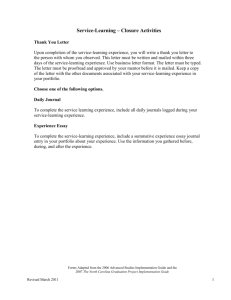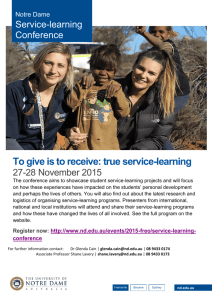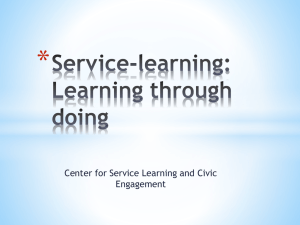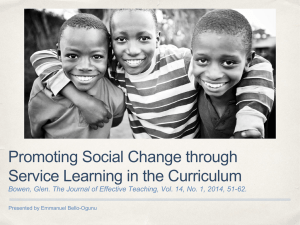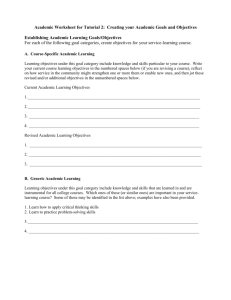Fall 2005, Vol. 4 No. 2 SERVICE LEARNING AS PEDAGOGY Abstract
advertisement
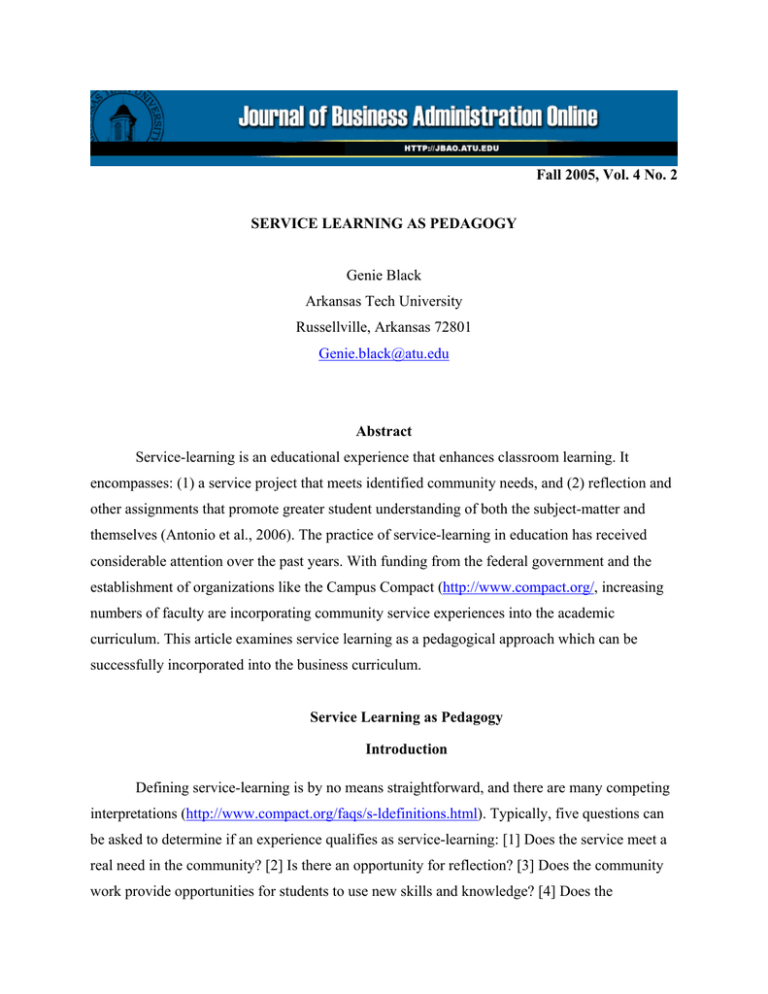
Fall 2005, Vol. 4 No. 2 SERVICE LEARNING AS PEDAGOGY Genie Black Arkansas Tech University Russellville, Arkansas 72801 Genie.black@atu.edu Abstract Service-learning is an educational experience that enhances classroom learning. It encompasses: (1) a service project that meets identified community needs, and (2) reflection and other assignments that promote greater student understanding of both the subject-matter and themselves (Antonio et al., 2006). The practice of service-learning in education has received considerable attention over the past years. With funding from the federal government and the establishment of organizations like the Campus Compact (http://www.compact.org/, increasing numbers of faculty are incorporating community service experiences into the academic curriculum. This article examines service learning as a pedagogical approach which can be successfully incorporated into the business curriculum. Service Learning as Pedagogy Introduction Defining service-learning is by no means straightforward, and there are many competing interpretations (http://www.compact.org/faqs/s-ldefinitions.html). Typically, five questions can be asked to determine if an experience qualifies as service-learning: [1] Does the service meet a real need in the community? [2] Is there an opportunity for reflection? [3] Does the community work provide opportunities for students to use new skills and knowledge? [4] Does the experience lead to an enhanced civic responsibility? and [5] Does the experience foster mutually respectful relationships between the community and institutions of higher education? (Alliance for Service-Learning in Education Reform; Giles, 1991; National and Community Service Act of 1990; Stanton, 1991). The definition of service learning from the Learn and Serve America National Service-Learning Clearinghouse (NSLC) is that service-learning combines service objectives with learning objectives with the intent that the service learning activity will change both the recipient and the provider of the service. This is accomplished by combining service tasks with structured opportunities that link the task to self-reflection, self-discovery, and the acquisition and comprehension of values, skills, and knowledge content (NSLC: 2004). Service-Learning as Pedagogy An appropriate definition of pedagogy is systematized instruction or principles that promote student learning. A number of out-of-the-classroom teaching approaches are already recognized as credible teaching pedagogies. Volunteerism, for example, typically involves student work without the link to an organized curriculum. Volunteerism involves the giving of time of your own free will to a cause that one believes in without expectation of financial reward (National Volunteer and Philanthropy Center; Penner, 2006). Students volunteer to be a part of the solution to community problems, learn new skills, develop interests and to meet new people. Field Experience provides another example of an out-of-the-classroom pedagogy. Field experience plays a major role in linking theory with practice. It involves actually placing a student in a real job that the student hopes to hold professionally upon graduation. Field experience is commonly used in teaching, nursing and many other academic programs http://www.und.edu/dept/ehd/fieldplacement.htm). In some instances, student work in field experiences may be done to advance career and professionals interests and may not necessarily provide a response to a need in the community. Similarly, there may be little focus on developing a sense of responsibility or a deeper understanding of structural roots of problems. Service-learning is generally distinguished from other out-of-the-classroom pedagogies in several ways (http://www.niost.org/publications/cns_4.pdf). In service-learning, there is a deliberate attempt to structure opportunities for reflection, it is directly linked to course material and it is designed to help students process an experience and generate learning from this. It is here that faculty play a critical role by helping students to link up experience with relevant literature and academic content. Why Engage in Service Learning in the Business Curriculum? Business faculty engage in service-learning for a variety of reasons (refer to Table 1). Some faculty engage in service-learning because they feel that these business community experiences both serve the business community and provide students with learning opportunities that may not be possible through the use of other pedagogies. For instance, when students are involved in service-learning, it may be possible to engage them more actively in discussions about the application of theory and research. Involvement in community-based work pushes students to consider how research and theory are played out in the real world. In courses where students are involved in work with individuals with whom they have little prior experiences, faculty may have an opportunity as well to help students develop multicultural awareness and an appreciation for diversity. When faculty consider adopting service-learning in a course, they need to think carefully about what course objectives they have in mind and how this experience will be integrated into the course itself. Several questions need to be addressed: [1] Will the service be required or optional? [2] How many hours are students expected to serve over the course of the semester? [3] Will service be an integral part of the course, that is to say, will these experiences be discussed in most class meetings and serve as a central 3text2 for the course or will the service be a smaller part of the course? [4] How will the service be linked to the academic content of the class? and [5] How will student learning be evaluated? Answers to these questions along with consideration of the aims and claims of service-learning will fashion a faculty member’s general approach to using this pedagogy. Table 1 Reasons for Engaging in Service Learning Cognitive thinking skills Linking and testing theory and practice Understanding of larger structural forces Problem solving Construction of knowledge Learning about learning from experience Critical inquiry Process vs. content-based learning Citizenship Civic development Democratic values Sense of efficacy Public participation Moral and ethical development Values clarification Commitment to the larger community Tolerance and multicultural values Career exploration Community knowledge Sense of community on campus Life long learning Disciplinary and curricular options What Makes a Service Learning Project Meaningful and Effective? Well-developed and thought out service learning projects result in meaningful experiences and effective approaches to critical thinking and problem solving. Following are some suggestions for assuring that a service learning project is successful. Service-learning projects must include academic preparation, service activities, and structured reflection. Equipping students with the knowledge and skills needed for service is vital in order for the project to be both meaningful and effective. This includes teaching students about their business community and how to identify needs, as well as providing them with the specific skills needed to perform the service activity. It should include an exploration of why it is important to perform service and what it means to be an active business citizen. Ideally, servicelearning should be used to teach curricular objectives, so preparation activities could be tied to classroom lessons. Students work to identify business needs and devise and participate in projects that address those needs. Service-learning business projects should be designed to meet existing course outcomes in an experiential manner. Service-learning provides an opportunity for classroom knowledge to be applied and tested in real-life settings. Engaging students in high quality service-learning experiences develops vital skills needed for business careers. Students should be given plenty of opportunities to think about the service performed and how it impacted the organization. Reflection involves considering what worked well and what could be changed to make the project better. This contemplation and evaluation should occur throughout the service experience, not just at the end of the project. Through reflection activities in the form of discussions, journaling, performing, writing, etc., students come to more fully understand the connection of their curriculum to the service work performed. Reflection helps students explore the cycle of: What & Why? So What? Now What? High quality service-learning allows students to take leadership and ownership over the projects performed. Students learn important school, work, and life skills such as working as a team, organizing and scheduling activities, and problem solving when given increased responsibility for the success of projects. Service-learning experiences provide opportunities for students to learn about the business community, explore career possibilities, and work with diverse groups of individuals. Quality projects involve community organizations as partners. Table 2 presents some of the questions to ask while designing a service learning course or component. As with all effective instruction, an action plan must be created which features specific objectives to be achieved through the service learning activity. Service-learning requires faculty, students, and business community organizations to carefully plan out projects and work collaboratively. Finally, to effectively engage in a project, students must understand the issue they will be addressing. As part of preparing to engage in service-learning, students are often required to conduct research, read articles, and listen to guest speakers. Students also need to learn project specific skills, as well as explore issues related to the business and the community. For service learning reflection to be effective, outcomes must be specified precisely. If outcomes are specified too broadly (e.g. communication skills) it may be difficult to devise appropriate reflection activities and to develop appropriate assessment techniques. Faculty can use a wide range of service learning outcomes as a starting point for establishing specific service learning outcomes. Before designing reflection, faculty must select appropriate service activities. Unless service activities are structured in a way that supports the acquisition and reinforcement of specific disciplinary content and desired educational outcomes, it will not be feasible to incorporate reflection to support those outcomes. Table 2 Questions to Explore While Designing Service Learning 1. Are students meeting a recognized need in the business community? (e.g., Does the service learning project meet a specific need of one or more businesses? How is the service learning project organized? And by whom? 2. Is the service learning project meeting curricular objectives? (e.g., What skills are students learning through service-learning? What curricular content are students learning through service-learning? 3. Are students reflecting throughout the service-learning experience? (e.g., Who gives students a response as they reflect? Their peers? The teacher? The community agency? When do students reflect? How is the reflection structured to get the most meaningful response and discussion possible and maximize student learning? 4. Does the service learning project develop student responsibility? (e.g., How often do students work together in service-learning? What percent of service-learning is teacher driven verses student driven? Who plans and organizes the service-learning? 5. Does the service learning project establish community partnerships? (e.g., Do students consult with a business community partner for information and resources relevant to the issue the service-learning project addresses? Are opportunities created for students to interact with business leaders? 6. Are students equipped with knowledge and skills needed for the project? (e.g., What do students need to know to serve successfully? Do their needs change as they service-learning progresses? How? Do students possess the knowledge and skills at the start of the project? Are relevant knowledge and skills introduced as the need arises or the project changes? The Use of Reflection in Service Learning After designing outcomes and service activities, faculty must consider the question: How can reflection be used to enhance a particular outcome? A key issue to consider is the timing of the reflection. Reflection activities before, during, and after the service activity can contribute to an outcome in different ways. Finally, faculty must consider how the outcomes will be assessed. One key issue to consider in designing service learning is the link between reflection and assessment. Assessment can have multiple purposes. One important purpose is to provide feedback to students on what is expected of them, what they have done well, what they need to improve on and how (cf. Learn and Serve America National Service-learning and Assessment Study Group 1999). Reflection is a key part of such assessment. Structured reflection activities conducted on an ongoing basis provide a means for assessing student progress towards service learning goals and for providing feedback. Since faculty may not be able to directly observe the service activities of students in detail, reflection may also be the key to the assessment of service learning for grading purposes. For example, service learning may be graded on the basis of a presentation and/or integrative term paper. For service learning to be effective in accomplishing specific outcomes, service activities must be appropriately structured. For developing project management skills through service learning, students must have an opportunity to practice each of the four categories of skills listed above. Thus students must be given an opportunity to participate in developing community/learning outcomes, planning resource use, executing and managing projects in the community, and in planning for the continuity of projects. Conclusion On a national level, faculty members are involved in service-learning across the disciplines. Syllabi and publications available from Campus Compact (http://www.compact.org/resource/essentials-lresources.html) are good illustrations of this, as is the upcoming series on service-learning in the disciplines published by the American Association for Higher Education. There are a number of ways that service-learning has been applied across the curriculum. In addition to the variety of sites service-learning happens, there is also a wide variety of curricular options that faculty have used to tie community based work to the curriculum. These range from one-shot community immersion experiences to the involvement of students, two semester-long participatory action research projects where the service becomes a critical and central component of course work. Campuses have also developed a fourth-credit option where students gain one extra credit for service- learning experiences. On a growing number of campuses, students must complete a service-learning course as a requirement of graduation. How large a part of the curriculum service-learning becomes is very much a matter of how faculty and administrators view this pedagogy, and how they work within the institutional environment to make it a recognized and rewarded practice. Within the scope of modern university culture, service learning is a very rapidly growing educational movement that holds the promise of more successfully integrating the student’s abstract conceptual development with their career, social and moral development. According to the National Service Learning Clearinghouse (NSLC), the quality of personal interaction in service learning allows a more phenomenological approach to learning. Granting intellectual privilege in the classroom to personal reflections on the meaning of their service encounters… “promotes deeper learning because the results are immediate and uncontrived. There are no "right answers" in the back of the book. As a consequence of this immediacy of experience, service-learning is more likely to be personally meaningful to participants and to generate emotional consequences, to challenge values as well as ideas, and hence to support social, emotional and cognitive learning and development” (NSLC, 2004). The previous information makes a strong case for viewing service learning as a credible teaching strategy in the business curriculum. It can be used by faculty to encourage students to make connections between classroom learning and the larger community. The consensus of scores of articles and books written about the benefits of service learning is that service learning, when done effectively, greatly enhances the educational experience for students and teachers, and for the university and community at large. References Alliance for Service-Learning in Education Reform. Standards of Quality for School-based Service Learning. May, 1993. American Institute of Certified Public Accountants (AICPA). 2001. AICPA Core Competency Framework for Entry into the Accounting Profession. New York, NY: AICPA http://www.aicpa.org/edu/corecomp.htm. Retrieved November 12, 2005. Antonio, A. L., Astin, H. S., and Cress, C. M. (In press). Community service in higher education: A look at the nation's faculty. Review of Higher Education. Astin, A. W. (1984). Student involvement: A development theory for higher education. Journal of College Student Personnel, 25, 297-308. Gelman, S., B. Holland, et. al. 2001. Assessing Service-Learning and Civic Engagement: Principles and Techniques. Providence, RI: Campus Compact. Giles, Dwight, Ellen Porter Honnet, and Sally Milgore (editors). Research Agenda for Combining Service and Learning in 1990s. Raleigh, N.C.: National Society for Internships and Experiential Education, p. 7, 1991. http://www.niost.org/publications/cns_4.pdf. Retrieved January 8, 2006. http://www.und.edu/dept/ehd/fieldplacement.htm. Retrieved December 11, 2005. Learn and Serve America National Service-learning and Assessment Study Group. 1999. Service-learning and Assessment: A Field Guide for Teachers. http://www.umn.edu/~serve/guide1.pdf. Retrieved January 13, 2006. Learn and Serve America National Service-Learning Clearinghouse (2004). Service-Learning Is... http://www.servicelearning.org/article/archive/35/. Retrieved March 3, 2005 National and Community Service Act of 1990 definition of service-learning from Rich WillitsCairn and Jim Kielsmeier's Growing Hope, Minneapolis, MN: National Leadership Council, p. 17, 1991. National Volunteer and Philanthropy Center. http://www.nvpc.org.sg/extras/printarticle.asp?site=Main&aid=186. Retrieved February 3, 2006. Penner, Louis A. (2004). Service Learning in the Classroom. Journal of Social Issues, 60, pp. 645 - 670. Roufs A. L. 2000. Assessment and Evaluation in Service-learning Topic Bibliography. http://www.umn.edu/~serve/res/bibs/assessment.pdf. Retrieved December 1, 2005 Stanton, Timothy. Service Learning: Groping Toward A Definition, from Jane C. Kendall and Associates, Combining Service and Learning. Raleigh: National Society for Internships and Experiential Education, 1991. Stott N. W., W. W. Schultz, Brei D., Hoffman D. M., Markus G. 2000. ProCEED: A Program for Civic Engagement in Engineering Design. American Society for Engineering Education Annual Conference Proceedings. http://www.asee.org/conferences/search/. Retrieved October 14, 2005


